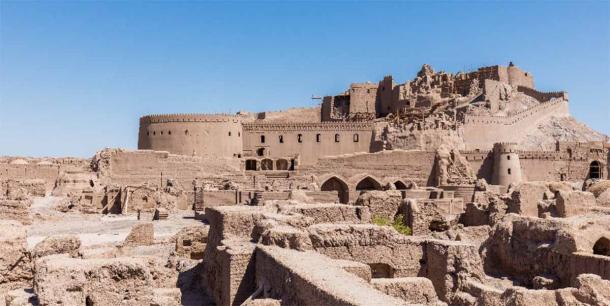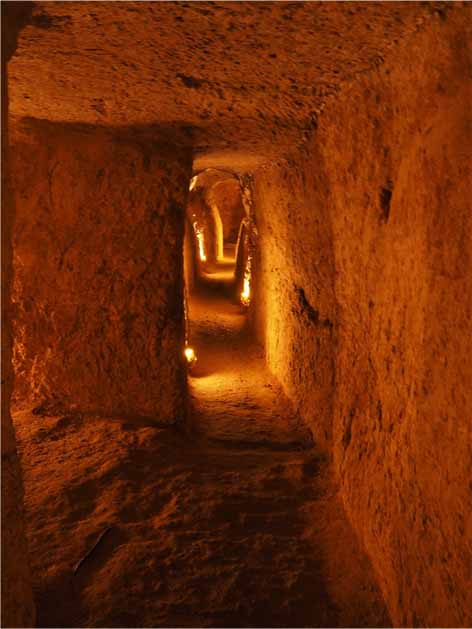
Medieval Underground Corridors Found in Iran During Roadwork
A routine road construction project has led to the accidental discovery of an extensive network of underground corridors in Bam village of Esfarayen county in northeast Iran. Archaeologists have linked the discovery to the nearby fortress of Shahr-e Belqeys (City of Belqeys).
“Remains of ancient underground corridors were discovered a few days ago during a road construction project in Bam village of Esfarayen county,” the Tehran Times reported, quoting an expert employed at the Belqeys archaeological site.
The Sprawling Mud Fort of Shahr-e Belqeys
The ruined citadel of Shahr-e Belqeys lies in the north-eastern part of North Khorasan province. Spread over 51,000 square meters (12.6 acres), it is the second-largest mud fortress in Iran, after the UNESCO World Heritage Site Bam Citadel.
- Arg-é Bam: An Ancient Citadel Destroyed by Nature and Reconstructed by Humanity
- Underground Cities and Networks around the World – Myths and Reality (Part 1)

The Shahr-e Belqeys site may have once appeared similar to the UNESCO World Heritage site Bam Citadel. Underground corridors have been found in both areas. The Bam Citadel was destroyed by the devastating 2003 Bam earthquake that cost over 26,000 lives, and is being reconstructed. (Diego Delso, CC BY SA 4.0)
Excavations at nearby hilltops and elevations have suggested that Belqeys is at least 6,000 years old, according to Arkeonews. Experts believe that it flourished from the late Sassanid era (224-661 AD) to the early Islamic period in the 7th century. However, it seems to have been active right until the time when Nader Shah Afshar (one of the most powerful rulers in Iranian history) assumed power in the early 18th century. There is historical evidence to indicate that Belqeys enjoyed the favor of Sassanid monarchs, leading to its prosperity. For example, a book on the history of Nishabur (Middle Persian: Nev-Shapur), the capital city of the Sassanians founded in the third century AD by King Shapur I, mentioned the importance of Belqeys under the Sassanids.
Several rounds of excavations in Belqeys have revealed the remarkable remains of the citadel itself, as well as houses, irrigation channels, a cistern, and a hypostyle hall.
- The Ancient Subterranean City of Nushabad: Why Were People Living Underground?
- The Magnificent Citadel of Erbil - A True Archaeological Sandwich

Ruined citadel of Shahr-e Belqys, site of the underground corridor discovery (Tehran Times)
The Network of Underground Corridors
Archaeologists have been aware of the existence of the underground retreat since last year, but access to it was blocked by the local cultural heritage directorate in order to protect it. Now, workers laying a road have stumbled upon this precious heritage from another spot. According to the Tehran Times, the Belqeys site expert said, “Last years, traces of this underground city had been discovered but to protect it, these remains were blocked by the local cultural heritage directorate. Now we reached these ancient structures from another place, which confirms the statements of the local people.”
He added that the total length of the corridors was 18 kilometers (11 miles) and, intriguingly, a bathroom and a mill were located along their extent. These have not been opened yet, however, and experts have yet to examine them.

The underground corridors found near Shahr-e Belqeys are similar to those built during the same period in Nushabad (Never.Stop.Searching / CC BY ND 2.0)
“The ruins have yielded potteries estimated to belong to the Seljuk period, IlKhanid, and even earlier periods. However, an extensive archaeological excavation is needed to delve into its secrets,” he also said, according to the Tehran Times.
Are there more underground corridors in Iran?
Although perhaps not as famous as the underground cities built by Bronze Age cave dwellers in Turkey’s Cappadocia, Iran has several underground architectural sites of its own. In fact, the cone-shaped underground homes of Kandovan village in north-western Iran resemble the “fairy chimneys” of Cappadocia.
In 2018, the 3rd International Troglodytic Architecture Conference was held in the country, attended by scores of experts and scholars. The conference discussed subterranean architecture, technology and culture.
Another underground site in Iran is the fascinating city of Nushabad, known locally as Ouyi, located in Isfahan province in central Iran. Located at depths varying from 4 to 18 meters (13 to 59 feet), it is an entire city of passages and chambers. It dates to the Sassanid times, and one reason that experts have advanced for the building of this underground expanse is protection from the blazing summer daytime temperatures in the region. However, more plausibly, it was a safe retreat for women, children and the elderly in times of invasion, to which the region was particularly prone.
The fact that the Shahr-e Belqeys underground corridors are similar in construction to Nushabad leads experts to believe that they perhaps served the same purpose. Further excavations, subject to the approval of the Iranian government, will throw more light on their architecture and use.
Top image: The recently discovered underground corridors near Shahr-e Belqeys appear similar to this photo of the subterranean site of Nushabad. Source: Fotokon / Adobe Stock
By Sahir Pandey
References
Altuntas, Leman. October 1, 2022. Medieval Subterranean Corridors found by Accident in Northeast Iran. Arkeonews. Available at: https://arkeonews.net/medieval-subterranean-corridors-found-by-accident-in-northeast-iran/.
Medieval Subterranean Corridors found by Accident. September 12, 2022. Tehran Times. Available at: https://www.tehrantimes.com/news/476673/Medieval-subterranean-corridors-found-by-accident.
Shahr-e Belqeys Prosperous in Late Sassanid, Early Islamic Eras: expert. September 29, 2020. Tehran Times. Available at: https://www.tehrantimes.com/news/453045/Shahr-e-Belqeys-prosperous-in-late-Sassanid-early-Islamic-eras.
















Comments
Unless there is ancient literature that talks about the construction of this subterranean infrastructure, and I have seen nothing of that sort, we MUST assume that the tunneling/carving through the limestone was the work of the pre-Ice Age (Atlantean era) civilization that was wiped out by calamity that caused the long Ice Age/nuclear winter.
Nobody gets paid to tell the truth.